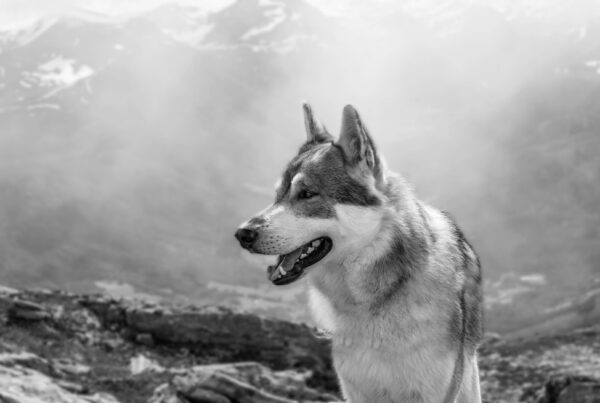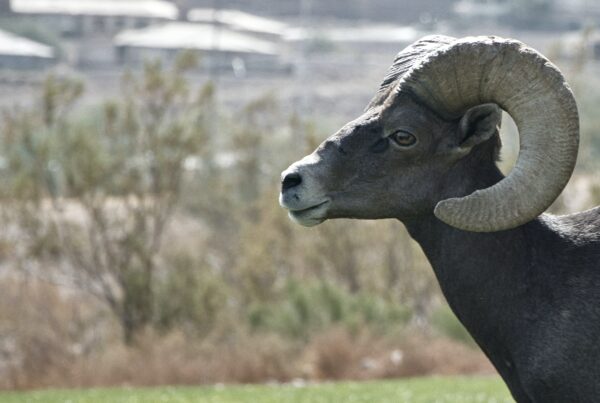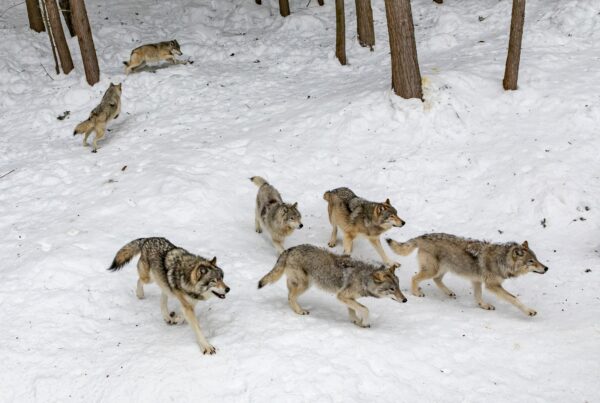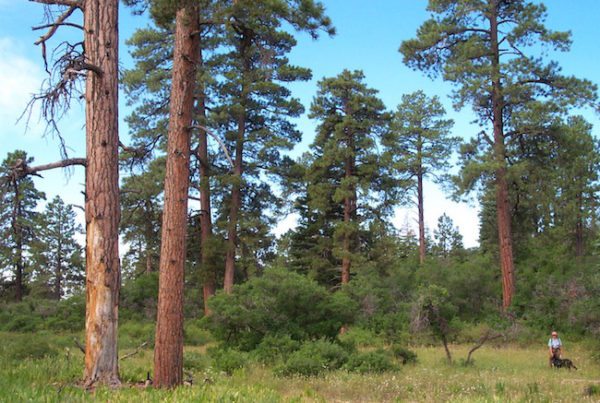Wolves have come home to Colorado.
Wolves have long stirred strong emotions in this country and still do. The idea of bringing wolves back to Colorado generates passionate support as well as die-hard opposition. Yet from an ecological standpoint, wolves belong here. And the science is clear: we can manage their presence effectively.
2024 Update
Livestock interests filed a petition to the CPW Commission, requesting that further reintroductions be delayed until certain conditions were met. Most of those conditions have been met, and it’s expected that the Commission will reject the petition and that as many as 15 wolves from British Columbia will be released by the end of February 2025.
Release of more wolves is vital to the success of the restoration effort. If no wolves are released this winter, it’s unlikely that those released last year will produce enough pups to create the self-sustaining population required by passage of Proposition 114.
Two of the wolves produced a litter of pups, which became known as the Copper Creek Pack. Over the course of the summer and fall, those wolves, mostly the adult male, were responsible for several livestock depredations. In early September, the individuals were captured. The male of the pack had a serious injury, and in spite of veterinary treatment by CPW, died in captivity. The adult female and 4 pups are still in captivity, but the expectation is that they will be released by early 2025. A fifth pup was discovered through game camera monitoring but could not be captured. It’s likely that pup is still alive and it may have joined with some of the other released wolves.
The Wolves Return
San Juan Citizens Alliance has spent over 20 years advocating for habitat protection in the San Juan Mountains. In 2019, we joined the Rocky Mountain Wolf Project, a coalition that put a ballot initiative on the 2020 Colorado ballot. The initiative passed, requiring Colorado Parks and Wildlife (CPW)to reintroduce wolves to the Western Slope by the end of 2023.
CPW created 2 advisory boards to help them develop the Colorado Wolf Restoration and Management Plan, which was approved by the CPW Commission in May of 2023.
On December 18, 2023, the first five wolves from Oregon were released near Kremmling in north-central Colorado. Another 5 were released in the following week. CPW plans to release 10-20 wolves per year for 3 years, and then pause to evaluate the success of the reintroduction. The plan includes a robust compensation program for livestock owners who lose their animals to wolves and provides goals for removing wolves from their current place on the state’s threatened and endangered species list.
The History
EXTIRPATION
Gray wolves once thrived throughout North America, from coast to coast and from Mexico all the way to the Arctic. But when hunters drove down the large mammal populations on which they depended, wolves turned more to livestock. This, of course, sealed their fate. The remaining wolves were hunted down by humans – shot, poisoned, and trapped until the 1940’s when none remained in Colorado and the rest of the lower 48 states, except for a small population in Minnesota.
REINTRODUCTION
In the 1960s, gray wolves earned federal protections through what eventually became the Endangered Species Act, under which recovery of the species was mandated. In 1995, after 20 years of effort, 66 gray wolves from Canada were relocated to Yellowstone National Park and central Idaho. Now wolves are being returned to their rightful place in Colorado.
Support Wolf Restoration
The Rocky Mountain Wolf Project, with SJCA’s support, created the “Born to be Wild” license plate that will fund programs to prevent conflicts with gray wolves through non-lethal means.
The plate offers an opportunity for supporters of wolf restoration to provide financial support for methods that will reduce negative interactions between wolves and livestock, increasing acceptance of wolves in the ranching community.
There is an annual additional $50 fee for your ‘Born to be Wild’ license plate. The revenues generated go directly to Colorado Parks and Wildlife to fund non-lethal conflict reduction programs and tools.
In 2024, the license plate generated more than $600,000, most of which will support CPW’s “Range Rider” program. That effort will ensure that the ranching community will have access to funds and training that will use human presence to reduce wolf depredation on livestock.
Get your “Born to be Wild” license plate today and help minimize the conflict or wolf restoration in Colorado!

Wolves belong in Colorado, plain and simple. Intentional, effective reintroduction was the only sure way to restore Colorado ecosystems and strengthen the genetic resiliency of North American populations. We’re proud of our work that is to helping to bring wolves back home.

“The last word in ignorance is the man who says of an animal or plant, “What good is it?” If the land mechanism as a whole is good, then every part is good, whether we understand it or not. If the biota, in the course of eons, has built something we like but do not understand, then who but a fool would discard seemingly useless parts? To keep every cog and wheel is the first precaution of intelligent tinkering.”
Aldo Leopold, Father of Wildlife Management
Reasons to Restore Wolves in Colorado
Wolves Perform Important Ecological Functions
There is no question that wolves cause profound change in the behavior of their prey and improve prey population health, creating other positive effects in their environment.
Gray wolves evolved approximately 300,000 years ago, and though many large animals have since disappeared, the wolf has continued to survive and thrive (except when faced with determined human efforts to eradicate them). Wolves now specialize in hunting ungulates (hooved animals), including elk, deer, caribou, moose and bison.
Because wolves evolved together with their prey and ecosystems, wolf hunting behavior causes changes in prey behavior that are critical to a healthy, functioning ecosystem. When wolves were eradicated from Yellowstone, deer and elk populations boomed for decades, decimating willow, aspen and cottonwoods. The riverbanks eroded, beavers and songbirds birds struggled, and even scavengers were pressed to survive.
Now, nearly 30 years after wolves were introduced to Yellowstone, we’ve seen that ecosystem bounce back. Wolves not only keep populations of wild ungulates in check, but also disperse them, distributing their impact. Trees and shrubs are thriving again, stabilizing the soil and riverbanks, and also providing homes for birds and food for beavers. Scavengers can find more leftover food from wolf kills and beaver dams store more water and provided habitat for numerous other species. Learn more about these impacts below:
Prey Behavior
Hunting by wolves causes changes in prey behavior, which can create environmental change. In Yellowstone National Park, changes since wolf reintroduction in 1995 include improved conditions in riparian areas and higher survival of aspens and willows. Most researchers attribute these changes to shifts in elk behavior. Elk that stay on alert to the presence of wolves are less likely to remain in riparian areas for long periods, resulting in less intensive browsing.
Can we directly attribute these effects to the presence of wolves, and will the same effects occur if wolves are restored to Colorado? Based both on the experiences in Yellowstone and ecological theory, there is a qualified “yes” for both questions. We know for certain that elk will respond behaviorally to wolf presence, and that change in behavior will almost certainly cause positive changes in environmental conditions.
Prey Selection
Wolves prey on the most vulnerable individuals, quickly determining which animals are vulnerable in any way and then focusing on them. In the case of elk, those are the young and older females. Vulnerable animals are not only easier to catch, they also are less likely to injure wolves during the hunt.
In a Yellowstone area study, the average age of adult females killed by hunters was 6.5 years, an age where they have multiple years of reproduction ahead of them. In contrast, the average age of adult females killed by wolves was 13.9 years, or near the end of their reproductive years. Removal of more animals in their prime reproductive years makes the population less resilient and less able to respond to factors (like a harsh winter) that reduce population size. The bottom line is that wolves remove weaker individuals, which results in healthier prey populations.
Vegetation
Vegetation studies suggest changes in vegetation that occurred in Yellowstone National Park after wolves were reintroduced were likely caused by changes in prey behavior and not by reductions in prey populations. The prevailing belief is that prey animals (particularly elk) are more alert and spend less time in any one location when wolves are in the vicinity.
Riparian areas, those thin bands of vegetation along streams and lakes, are one of the vegetation types showing significant positive change. Some researchers attribute those changes to the fact that elk don’t spend as much time in those areas, allowing willows and cottonwoods to survive and grow due to less browsing by elk. There are other researchers who think the explanation is more complex and that beavers are a key factor in the re-establishment of healthy riparian vegetation. What is clear is that conditions have improved for beavers, songbirds, and small mammals. The habitat is better for elk as well, because their food sources are both more abundant and more nutritious. The degree to which these improved conditions can be attributed to wolves is still a point of disagreement, but it’s certain that some of the positive effects are due to the presence of wolves.
Scavengers
Many species, from bald eagles to bears to beetles, rely on the carcasses killed by wolves to survive. In one study, researchers observed 221 prey carcasses killed by wolves in Banff National Park and observed 20 different species on those carcasses.
Most common were ravens, coyotes, black-billed magpies, pine martens, wolverines, and bald eagles; others, in descending order, were gray jays, golden eagles, long- and short-tailed weasels and least weasels, mink, lynx, cougars, grizzly bears, boreal and mountain chickadees, Clarkʼs nutcrackers, masked shrews, and great grey owls. In Yellowstone, they noted twelve scavengers, of which five visit virtually every kill: coyotes, ravens, magpies, and golden and bald eagles.
More species of beetles use carcasses than all vertebrates put together. Another study found 23,365 beetles of 445 species in two field seasons at wolf-killed carcasses. No predator feeds as many other creatures as wolves do.
Colorado is the Missing Link for Genetic Resiliency
The original range of Canis lupus in North America extended from the far northern edge of Alaska to central Mexico and from the west coast to the east, except for the southeastern United States, where it was replaced by the red wolf, Canis rufus. But wolves have been driven out of their natural habitats and now only occupy about 10% of their former range.
Many young wolves disperse from the area they were born and look for opportunities to join other groups of wolves or start a new pack with another dispersing wolf. This mixing of animals with different genetic makeup and resulting different physical, behavioral, and physiological characteristics maintains the ability of populations to respond to environmental change, with climate change being one of the most important factors to consider today.
The small population of Mexican gray wolves (a subspecies of gray wolf, not a different species) in New Mexico and Arizona would benefit from the addition of genetic diversity from wolves moving in from the north. Similarly, the ability of wolves from the northern Rockies to move south and of wolves in the southern Rockies to move north would help ensure the genetic health of both populations. Restoring wolves to Colorado is the best way to rebuild this genetic interchange.

Intentional Reintroduction Allows Management Flexibility
Endangered Status
Any wild wolves in Colorado are listed as endangered under the federal Endangered Species Act (ESA). Even wolves that migrate into Colorado on their own are still fully protected as “endangered” under the ESA and management options normally would be very limited.
The ESA specifically prohibits “take” of listed endangered species. Take is defined as “…to harass, harm, pursue, hunt, shoot, wound, kill, trap, capture, or collect, or to attempt to engage in any such conduct.” In the case of wolves, strict enforcement of the ESA would prohibit actions such as chasing off a wolf that was stalking a flock of sheep.
VS.
Intentional Reintroduction
Colorado’s reintroduction has allowed for management through an “experimental nonessential” designation, an approach used for the reintroduction of wolves to Yellowstone and Mexican wolves in Arizona and New Mexico. The rule allowing that flexibility is commonly referred to as a “10j” rule, a reference to the section of the ESA that allows for the designation. The status relaxes ESA restrictions, treating the population as “threatened” rather than “endangered”, which allows greater management flexibility.
Colorado’s 10j rule was put in place on December 8 of 2023, allowing for actions that minimize or prevent wolf depredation on livestock that would otherwise be illegal under ESA endangered status, such as harassing or removing wolves that attack livestock and even lethal control. The classification is helping acceptance of restoration by livestock producers, local government officials, and others with concerns about wolf presence.
It’s the Right Thing to Do
Some of us view restoration as an ethical or moral obligation, because every species has an inherent right to live, and extirpating species is an ethical error. Others take a religious stance resting on the notion of protecting creation. These views end in the belief that protecting and restoring species is the “right” thing to do; that is, it’s a value judgment.
Our knowledge of the ecological role of large predators has also grown in the last century, and we’ve learned just how important wolves are to the ecosystems where they evolved.
Both for the inherent value and right to existence of wolves themselves, and for the value of intact ecosystems, restoring wolves to Colorado is the right thing to do.





Recent News (More)






